Eastern Phoebe (Sayornis phoebe) is a common, brown-gray flycatcher with a pale yellow belly, dark head, and long, dark tail.
If you see a small, perched bird that is dark above, pale below, and moves its tail up and down, you might be watching an Eastern Phoebe. This flycatcher is common in open woodlands and often lives near people.
Have you ever wondered how to identify the Eastern Phoebe? See this article to learn all about this common bird!
On this page
Identification
Male
The male Eastern Phoebe is a smallish flycatcher with brown-gray upperparts, and either pale yellow or white underparts. They have a plain, blackish or dark brown head, a white throat, and have a gray wash on their chest and part of their flanks.
These birds also have a medium-length but somewhat stout black beak, and long, dark wings with a hint of buff wing bars. We can also see white edging on the feathers of the lower part of their wings.
Eastern Phoebes have a quick direct flight. We usually see them flying out from and returning to their perch.
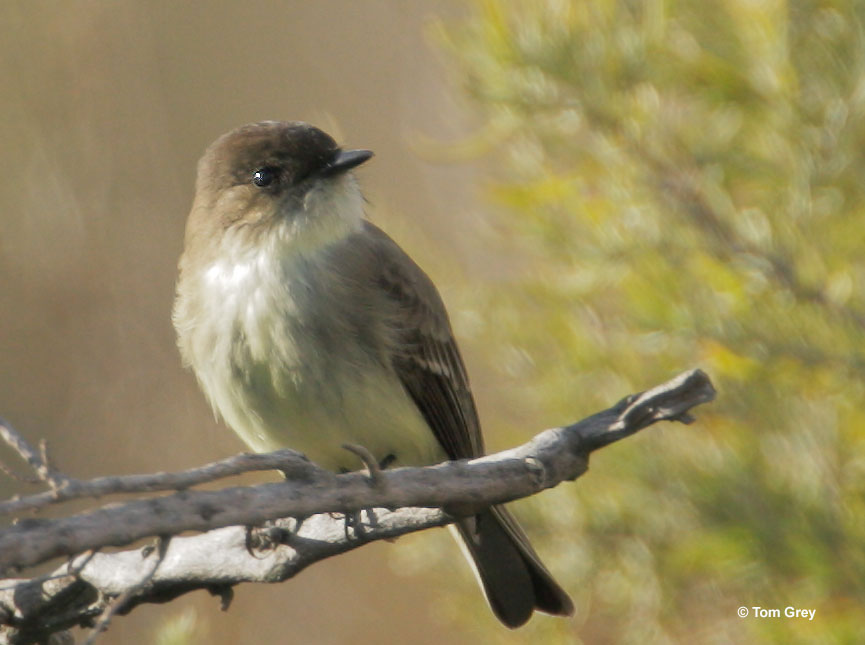
Female
Female Eastern Phoebes look just like the males. Males tend to be a little bit bigger, but the differences are far too small to notice. Like males, females are gray-brown above but darker on their head and tail.
On average, Eastern Phoebes are around the same size as a grosbeak. They are 7 inches long, have a 10.5 wingspan, and weigh 0.7 ounces.
Both sexes have a longish, dark brown or blackish tail with a bit of white on each side. When perched, this species’ habit of wagging or bobbing its tail up and down is one of the best ways to recognize it.
Vocalizations
Both sexes of the Eastern Phoebe make two main vocalizations. One is a sharp chip note that birds regularly make, especially during migration and winter. When they are alarmed, they also give a louder version of this chip call.
Males also frequently sing their own name. They make a double-noted, fairly high-pitched call where the second note is a busy trill. It sounds like, fee bee…fee beeyo. Females can also sing this song but don’t do it as often as male birds.
Food
Eastern Phoebes feed on flying insects, other arthropods, and small fruits. Like many birds, their diet is partly determined by what’s available.
For that reason, during spring and summer, they only eat small insects like flies, small moths and butterflies, beetles, and other little flying bugs. Although phoebes can eat all sorts of little flying insects, they eat more wasps and bees than any other types of arthropods.
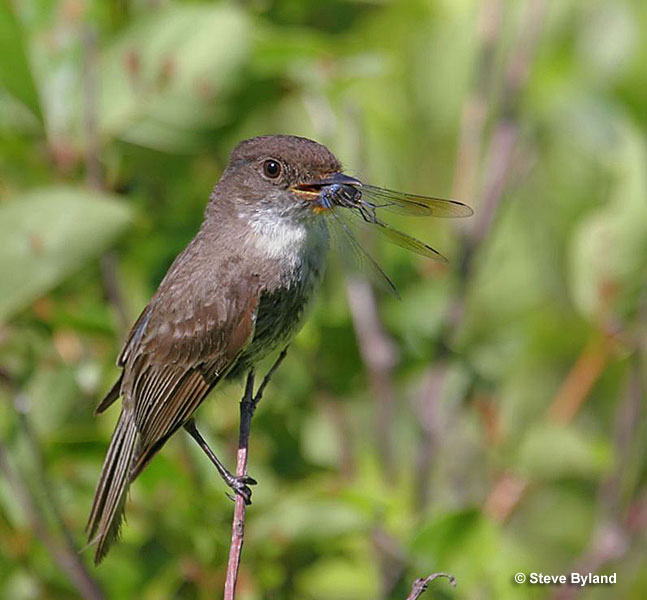
Some studies have shown that wasps and bees make up a quarter of their overall annual diet. They avoid getting stung by using their beak to keep the insect away from their face. Then, they might bash it against a branch to remove its stinger.
Whether catching a wasp, beetle, or other bug, Eastern Phoebes swallow their prey whole.
These flycatchers forage for invertebrates by flying out from a perch and catching the food item in flight. However, they also occasionally hover to pick insects from foliage, and fly down to catch insects on the ground.
In winter, Eastern Phoebes eat a lot more fruit. If insects are available, they will catch them but mostly feed on small berries. They forage for fruit by perching in a bush or tree, or hovering, and picking the berries with their beak.
Nesting and Eggs
Eastern Phoebes arrive on their breeding grounds in March and April and form pairs right away. Shortly after, the female picks a suitable nesting site next to or over water. They can choose a phoebe nest from the previous year or an old robin or swallow nest, or build a completely new nest.
Their nests are built on structures such as bridges, culverts, houses, cliffs, and on other hard surfaces. They are also constructed under some small covering and on a dry surface.
Although her mate accompanies her, the female Eastern Phoebe does all of the nest construction. She uses bits of mud to plaster together grass, twigs, moss, and other bits of vegetation to form a cup nest 2.5 inches in diameter and 1.73 inches deep.
The female Eastern Phoebe lays two to six, white eggs that are 0.75 inches long and weigh 0.07 ounces each. She does all the incubation and the eggs hatch after a bit longer than two weeks. Both parents then feed their babies in the nest for another 16 to 20 days.
At that time, the young phoebes leave the nest and hide in nearby vegetation. They continue to be watched over and fed by their parents until they become independent two weeks later.
Current Situation
Eastern Phoebe habitat includes woodlands and open wooded areas near streams and other wetlands. They breed in central and southeastern Canada, and in much of the USA east of the Rockies. In winter, we find Eastern Phoebes in similar habitats in a large part of the southeastern USA and eastern Mexico.
This flycatcher species is listed as Least Concern in the IUCN Red List and is a common bird throughout its big range.
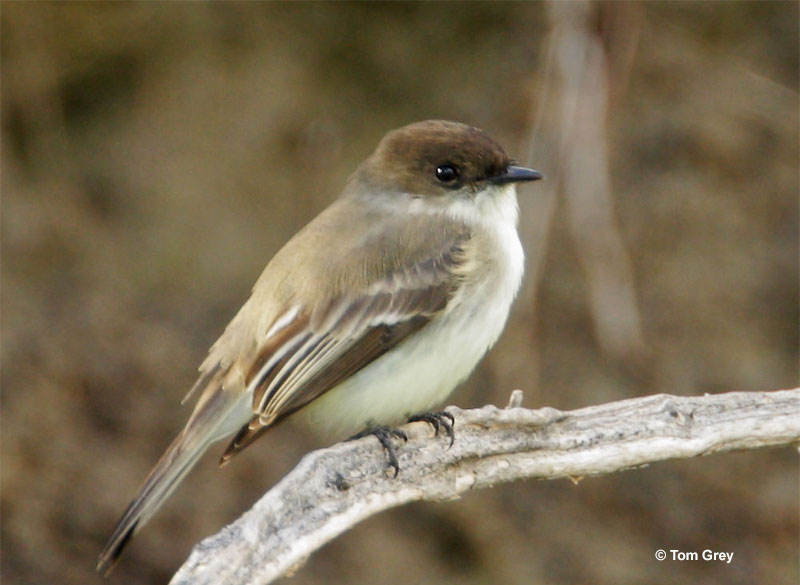
The Eastern Phoebe is not threatened and has a big estimated population of 33 million birds.
Although severe winters can cause some declines, overall, this flycatcher species has increased in most parts of its range.
Eastern Phoebes have increased and are doing well because they don’t migrate very far, and have lots of suitable habitat. However, most of all, bridges and other structures provide Eastern Phoebes with an abundance of possible nest sites.
Facts
- This flycatcher species winters further north than any other member of their family. In part, they can spend the winter as far north as New Jersey because they feed on berries. They are also one of the very first songbird migrants to come back in spring and the last ones to leave in fall.
- Eastern Phoebes can be attracted to certain backyards by installing structures that they use for nesting. These birds are great birds to have in the backyard because they eat lots of mosquitoes and other bugs!
- The Eastern Phoebe was the first known bird to be banded in North America. In 1804, to see if it returned to the same nesting area, John James Audubon put silvered thread on an Eastern Phoebe’s leg.
- Unlike many bird species, Eastern Phoebes do not flock together. Whether migrating, on their wintering grounds, or breeding, they are usually seen on their own. Nesting pairs use the same territory but they still forage alone.
- “Phoebe” is the name of an ancient Roman deity but this bird species was not named for that reason. The phoebe is named after its song, a vocalization that sounds a lot like, “phoebe”.
Similar Species
The Eastern Phoebe can look like a confusing bird that seems similar to some other flycatchers. However, with a close look, this species is actually pretty easy to recognize.
Eastern Wood-Pewee
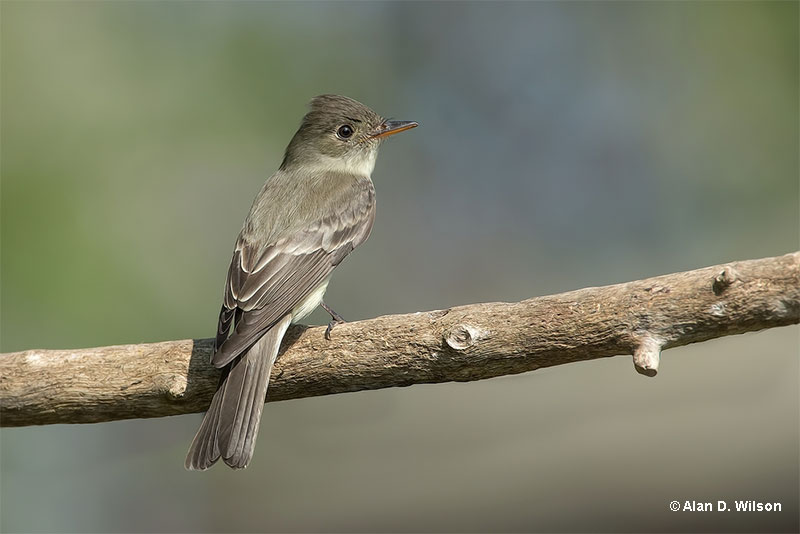
The Eastern Wood-Pewee lives in the same places as the Eastern Phoebe and has similar coloration. However, compared to the phoebe, its tail and head are not as dark, and it has two pale wing bars. Also, the Eastern Wood-Pewee does not wag its tail up and down.
Olive-sided Flycatcher
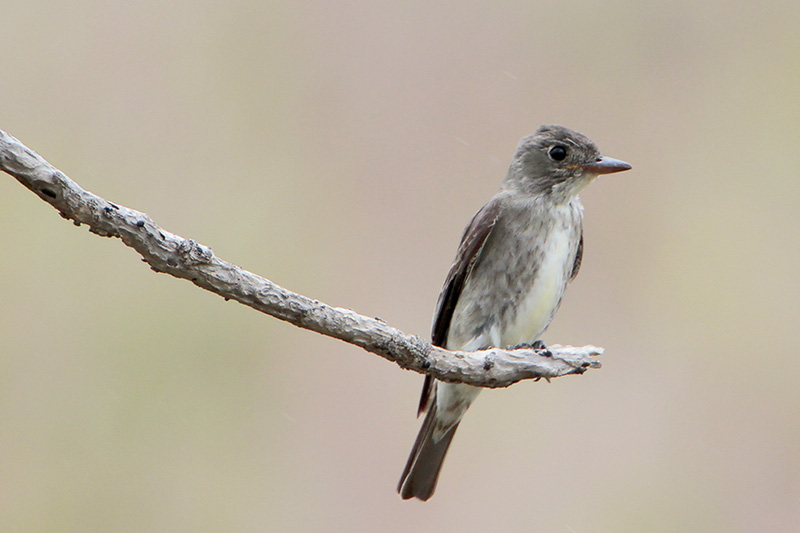
The Olive-sided Flycatcher is similar in size to the Eastern Phoebe, and also has similar coloration. However, it lacks wing bars and has distinctive dark flanks. In addition, the Olive-sided Flycatcher usually perches right at the top of a tall tree whereas the phoebe forages much closer to the ground.
Eastern Kingbird
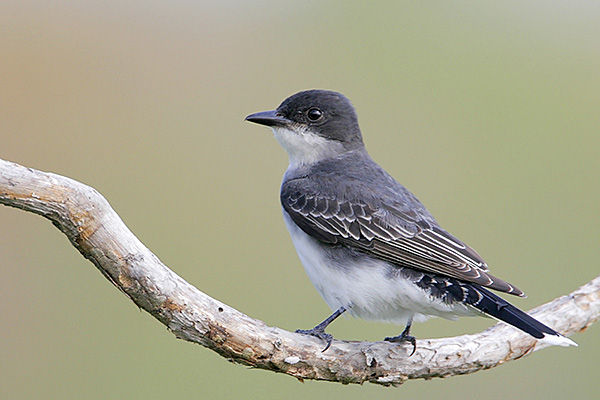
The Eastern Kingbird has a similar plumage pattern but differs from the Eastern Phoebe in a few key ways. Eastern Kingbirds have a prominent white tip on their tail, and frequent fields and more open habitats than the phoebe. The kingbird is also black, gray, and white, while the phoebe is dark brown, white, and pale yellow.
Frequently Asked Questions
What is the difference between Eastern and Western Phoebe?
The difference between Eastern and Western Phoebe is that Eastern Phoebes are dark brown above and pale yellow or white below. In western North America, the two other phoebe species are black and white, or gray and cinnamon.
What does the Eastern Phoebe symbolize?
The Eastern Phoebe symbolizes hidden knowledge and that people can live in harmony with birds.
What are the predators of the Eastern Phoebe?
The predators of the Eastern Phoebe include domestic cats and raptors like Sharp-shinned Hawks, Cooper’s Hawks, and owls. Snakes and small mammals can also prey on nesting and young Eastern Phoebes.
Are Phoebe’s aggressive?
No, Phoebes are not aggressive.

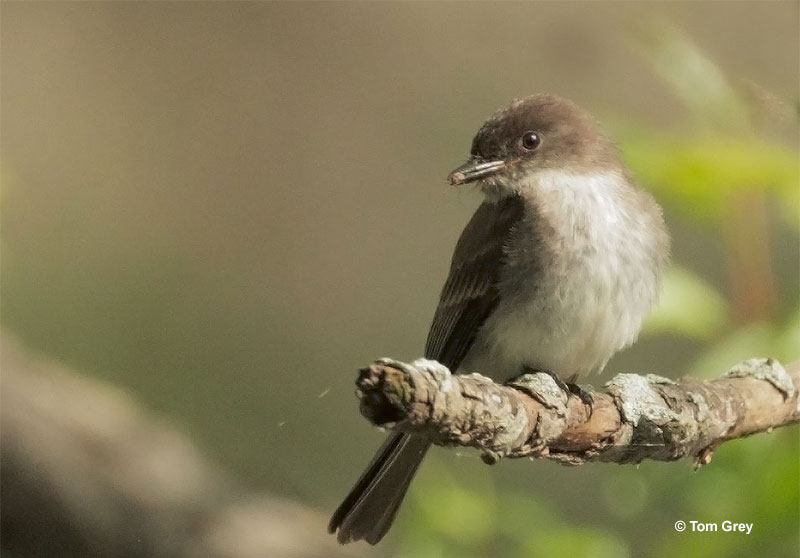

aari
Monday 1st of May 2023
very niceee